
http://www.iaeme.com/IJM/index.asp 232 editor@iaeme.com
International Journal of Management (IJM)
Volume 7, Issue 7, November–December 2016, pp.232–239, Article ID: IJM_07_07_024
Available online at
http://www.iaeme.com/ijm/issues.asp?JType=IJM&VType=7&IType=7
Journal Impact Factor (2016): 8.1920 (Calculated by GISI) www.jifactor.com
ISSN Print: 0976-6502 and ISSN Online: 0976-6510
© IAEME Publication
WOMEN CAREER INFLUENCERS IN INDIAN
LOGISTICS INDUSTRY
P. Uma Maheswari
Research Scholar, Alagappa Institute of Management,
Alagappa University, Karaikudi, Tamilnadu, India
Dr. R. Perumal
Professor, Directorate of distance education,
Alagappa University, Karaikudi, Tamilnadu, India
ABSTRACT
The emergence of Multinational business scenario in India has paved way for a tremendous
growth in its Logistics sector. India is spending more in for its logistical activities more than the
developed countries (SSKI). Witnessing the tremendous growth of the sector and its manpower
requirements, there exists still a skill gap that is unable to be matched. As a male-dominated industry,
women still find difficult to mark their excellence unlike the case of IT and other service industries.
In recent years, several major studies have demonstrated that having more female leaders, board
members, managers and supervisors leads to better business outcomes including higher levels of
productivity, safety and improved financial returns (PWC, 2016). It is being strongly perceived that
women have so many factors that acts behind them, especially in their career choice. In broad, they
can be classified as Environmental factors, Opportunity factors and Personal factors (Borchet,
2002). There are some more reasons added such as Job description, Personality, Social and
Economic factors that hinders the career growth of Indian Women (MADIKIZELA, 2008). This is a
theoretical paper that attempts to categorize and understand the importance of each of the factors
that affects the choice of women career with reference to the Indian Logistics Sector.
Key words: Women Career, Career Influencers, Gender Equality, Glass Ceiling
Cite this Article: P. Uma Maheswari and Dr. R. Perumal, Women Career Influencers In Indian
Logistics Industry. International Journal of Management, 7(7), 2016, pp. 232–239.
http://www.iaeme.com/IJM/issues.asp?JType=IJM&VType=7&IType=7
1. INTRODUCTION
The global annual logistics spend is valued at about USD 3.5 trillion. The annual logistics cost for the USA
is about 9% of GDP and internationally it varies between 9% and 20% of the GDP (Sahu, 2016). The annual
logistics cost in India is valued at Rs. 6,750 billion (US$ 135 billion) and it is growing at 8-10% annually
(Cygnus). For the period 2008 to 2022, the GDP is expected to grow between 7.5% and 8%31. Accordingly,
it can be projected that the Transportation sector would record a growth of 8.5% to 9% over the same period
(IMaCS) Logistics Industry is driven by the skills and quality of employed workforce that is now estimated
to be more than 40 million in India. With the growing manpower need at an exponential rate, the sector is

Women Career Influencers In Indian Logistics Industry
http://www.iaeme.com/IJM/index.asp 233 editor@iaeme.com
facing shortage in the availability of talented workforce as the industry has inculcated a serious myth in the
minds of the growing talents (CII, 2007). The major reasons for the skill gap that is prevailing in the sector
are mainly due to high attrition rates, improper recruitment practices and insufficient addition of manpower
to the existing pool at the right time (KPMG, 2007). Traditionally this sector is perceived to be operationally
hard laborious and male-dominated industry which hindered the growth of women workforce in this industry
even in ports and shipping (Sanjai, 2014). But, the women employment rate in transport and Logistics sector
has not been so significant (Nigam, 2010). Gender parity is witnessed both in the number of employed
personnel and the pay structure. The perception of operational hard labor and male domination at the
workplace hinder many women from joining the logistics sector, including ports and shipping. But, the new
generation women are perceived to have got the right aptitude and attitude to be employed in the logistics
industry. (Jain, July 2014).
2. WOMEN POWER IN LOGISTICS INDUSTRY
Having a women team will lead Logistics organizations to enjoy higher financial returns (PWC,
Transportation and Logistics 2030 report, 2016). The report also states that companies with more women
directors on board outperformed the others with a minimum of 16% in return on sales and 26% return on
investment. Such studies not only demonstrates the women power but also necessitates the importance of
gender diversity and inclusion which has not been practiced so far when it comes to the matter of business
leadership. Women, naturally have that ability to connect themselves with both the ends of the business and
women will play a vital role in establishing the anticipated level of last mile relationship. With improving
business conditions in India, male-dominated strongholds are being overwritten by opening up more
opportunities for women in the industry (Singh, 2015). It is also being understood from the same source that
other than back-end operations like Analytics and route-planning there are lot many avenues for women in
the front-end too, in which women have not been a part, so far. Several companies like DP World, DHL etc.
are towards increasing the number of women workforce in their organizations. These companies started
emphasizing through their women top officials that Logistics is not a problematic area for women to work
at all (Hall, 2013).
3. FACTORS INFLUENCING WOMEN CAREER CHOICE
Several studies have been made to narrow down the various factors that affects and effects the choice of
career with respect to women. Though the factors keep on increasing in number, there are some important
considerations which play a huge role in women career choice (Mutekwe, 2011).

P. Uma Maheswari and Dr. R. Perumal
http://www.iaeme.com/IJM/index.asp 234 editor@iaeme.com
Figure 1 Factors affecting Women career choice
Some factors are very common such as demographics and economic stability. But, there are some more
to the list that displays the changing perception of today’s women. These factors remain same for
determining the career choice of women across various industries. But, as far as the Indian logistics industry
is concerned, these are found to be predominant factors that every women would look in for. In that context,
the nature of logistics industry, its job descriptions, job environment and specifications keeps on improving
due to external pressure in this multinational business scenario (Nigam, 2010).
4. EDUCATION
It is only during the last 7 to 8 years that Logistics, Shipping and Supply chain management started gaining
their momentum as far as education and professional studies are concerned. As this sector is highly perceived
to be an unorganized sector as per various reports and the proportion of organized business operation is
comparatively less than 20% (JLL, 2015), there were hardly very few institutions with specific course of
focus. Even majority of the board room people in major Indian Logistics companies of India have not done
any education program in Logistics prior to their intervention to the industry (Sahu, 2016). Education and
training requirements peaks up for this sector in the country as the talent gap is getting extended year on year
with the intervention of ecommerce and necessity to do efficient logistics. The situation is now getting
different with more education programs of different levels and duration being offered on Logistics, Shipping
and Supply chain management among Indian universities and private bodies. But, the percentage of women
enrollment to these programs still remains under 10% (Interview feedback from CII Institute of logistics,
Chennai). Only 35% of the logistics graduates across the globe are women. The encouragement given by
schools to their students about their higher education and opportunities in Logistics sector plays a crucial
role, which if done will improve this percentage (Morailogistics). Leading movements like “Women in
Logistics” works internationally to improve the talents in this field thereby improving the number of women
Women career choice
Economic
Status
Education
Society &
Culture
Family &
acquaintances
Personality
Industry &
opportunities f
Work Life
Balance
Quality
Work Life

Women Career Influencers In Indian Logistics Industry
http://www.iaeme.com/IJM/index.asp 235 editor@iaeme.com
professional in Logistics Industry (Supplychain247, 2016). Education not only qualifies women but also
prepares them with confidence for picking up jobs in the Indian Logistics Industry.
5. ECONOMIC STATUS
Across the world, women in logistics industry are paid 20% less than men. As a male-dominated industry,
there still exists the glass-ceiling effect where women are unable to capture top positions. Apart from that,
there is also direct on-the-job discrimination which is due to the fact that women have more burdensome
parenting responsibility which makes them take a break in their career. When women are paid less, it is
normally substantiated with succession planning breaks and less availability when compared to that of men
in the office. The additional effect of smaller opportunities makes the gender-inequality more prominent
(Webb, 2016). The Gender gap report 2010 reports that even leading organizations in the world are partial
towards their women workforce in terms of recognition provided. It is also perceived that there exists barriers
for women even in occupying top positions of the organization. A report by Catalyst even says that
organizations that swears to promote the advancement of women in warehousing sector of New York does
not even have Female CEOs with them. In India, as logistics is concerned as a masculine field, women are
paid less and are positioned in support functions like administration, Finance, IT and Human resources
(Nigam, 2010). This makes women to be perceived as less important in this industry. But, with the growing
focus on the management analytics and decision making, it is believed that women could render a better and
unique style of working (Morailogistics). These are favorable situations for women to grab equal importance
and indeed greater advantage in terms of both monetary and non-monetary, than men in Indian logistics
industry in the near future (JLL, 2015).
6. SOCIETY AND CULTURE
There exists myth among the society, that logistics industry is more of physical extensive work, driving
trucks, handling containers and all of a rough work climate. It is being strongly perceived that because of the
masculine nature of the industry women are least preferred for this industry (Jain, July 2014) and the career
growth of women will not be as good as men. Apart from this, we live in a culture where women are
perceived weak literally and they cannot take up tasks and responsibilities. India is a very free society, and
because it is such a big democracy, choices are there for any part of the population. Cultural norms, however,
may often prevent women from making those choices. Indian Women are not always able to access
opportunities because they are not educated and other factors (Mehrotra, 2015). It’s this societal pressure to
be the sole family caretaker while single handedly managing the home that prevents many Indian women
from staying and thriving in technical roles. Even though the same case prevails around the world, the hurdles
that our Indian women face are deeply tied to the social structure and expectations that are intrinsic to India’s
culture (Kannan, 2015). A women Vice-president in an interview has deliberately told that to avoid herself
being perceived as a weaker sex in a male-dominated industry, she has cut her hair short to make it more
convenient for her. This clearly shows that women of the present era have started pursuing their passion with
strong conviction and utmost determination.
With the increase in the number of successful women occupying top positions in logistics organization,
this older conventions are being overwritten by their gestures and power (Woemn's power in teh Logistics
Industry, 2014). It has been found that power, advancement, type of work and the pride of associating
themselves with a prospective industry are expected to increase the motivation level of women employees
of current generation (ACCEL, 2015). All countries across the world, including India have started working
towards improving the women count in this sector with more efforts to increase the awareness, exhibiting
the employment opportunities for women and emphasizing on regular conduction of motivational program
to keep up the motivational level of present workforce in the industry.

P. Uma Maheswari and Dr. R. Perumal
http://www.iaeme.com/IJM/index.asp 236 editor@iaeme.com
7. FAMILY AND ACQUAINTANCES
In a recent NSDC report it has been clearly indicated that women career perseverance in Indian Logistics
industry is mainly affected by their family and associates. As mentioned earlier, women as considered to be
the sole responsibility for their family and children. Right from kitchen till taking tutorials for their kids,
men are perceived to have the least role. Dependency level of girl children on their families is very high
when compare to that of boys. In some families, parents decide on the type of employment that their
daughters should pursue. In spite of their economic situation, girls are asked to avoid logistics industry and
are advised to take jobs only in support activities, even at the worst case. After marriage, the same dictation
is done by her husband and his family. This clearly depicts that it is not just enough to create awareness
among the women job-takers but also their environment and keep continuously emphasizing that logistics
industry is safe for women to work and they are taken care of carefully. This is why very big organizations
like Maersk, DP World etc. have started providing women employee-friendly services that creates trust
among her environment and make her sustain and grow in logistics industry (JPS Supply Chain, 2016).
8. QUALITY WORK LIFE
This is an upcoming topic now, especially among women with the intervention of sophisticated and safe
working environment and practices in order to motivate and increase the productivity of the employees. It is
more focused towards the quality of human work experience in an organization. Improved quality work life
is expected to increase the competition for talent, skilled employees and increased women force (Srivastava,
2014). This is one predominant issue that Indian logistics industry is facing as most of the organizations are
still developing themselves to bring in better quality work life. In a shipyard or a container handling terminal
finding hygienic toilets itself is too hard. Sometimes you may have to walk into wash room crossing men
who are working in the dock, which makes women uncomfortable. Especially, in warehouses and Container
handling terminals where the safety related problems are highly witnessed, the number of women employees
are quite less in number and most of the time would be nil. In developed countries like UK and US, more
and more number of women employees can be found in ecommerce warehouse due to the technological
advancements that are adopted in the warehouses. They also show ergonomic concerns over their employees
thereby resulting in improved Quality work life. Even in that case, more number of sexual harassment cases
were filed. Sexual harassment is a common issue in warehouses (Illinois, 2012). This is supported by other
reports like “Women at Work, Women at Risk: Sexual harassment and assault in Will County warehouses”
and “Warehouse workers for Justice”. In India, with warehouse industry at its very nascent phase, it cannot
be concluded that warehouses are not women area at all. There are various organizations that would like to
ensure safer working environment for their employees by conducting regular audits. With increasing
manpower requirement in this industry, the so called grey area is expected to open up job opportunities for
women with right technology in terms of handling and stock maintenance combined with ergonomic
compliance in place (KPMG, 2007). By removing discrimination in career planning and growth, Logistics
industry can promisingly have more women workforce in the coming years.
9. WORK LIFE BALANCE
Employees with flexi-time work, day-shift work are more satisfied than the others as it improves the amount
of quality time that they can spend for their dependents and acquaintances (Kemmis, 2012). There is always
a flair, regardless of gender for jobs that provide opportunities for achieving better balance between their
work time and family time. A study also found that the difficulty of balancing life and work is a key reason
why women in India leave their jobs. While 24% of Indian men surveyed said they quit their jobs because
of long or inflexible working hours, for women that figure was 48% (Malhotra, 2013). Work life balance, in
fact is not just an issue in Logistics industry but other industries as well in India. As mentioned earlier,
organizations have understood the unique management style of women and so more opportunities have been
opened up for women in India. If the most receptive working system, Work from Home, gets introduced for
such off-floor works, it would help women achieving higher degrees of satisfaction (Cooper, 2012).


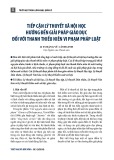
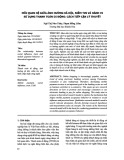
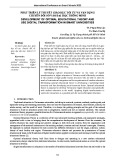

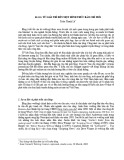
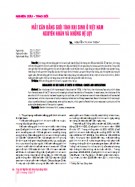
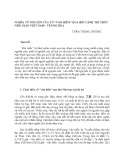




![Sổ tay Hướng dẫn truyền thông về lao động trẻ em [Mới nhất]](https://cdn.tailieu.vn/images/document/thumbnail/2025/20251114/kimphuong1001/135x160/7201763091001.jpg)

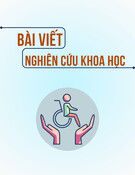





![Cẩm nang Thanh niên hành động [Mới nhất]](https://cdn.tailieu.vn/images/document/thumbnail/2025/20251017/kimphuong1001/135x160/1521760665202.jpg)




